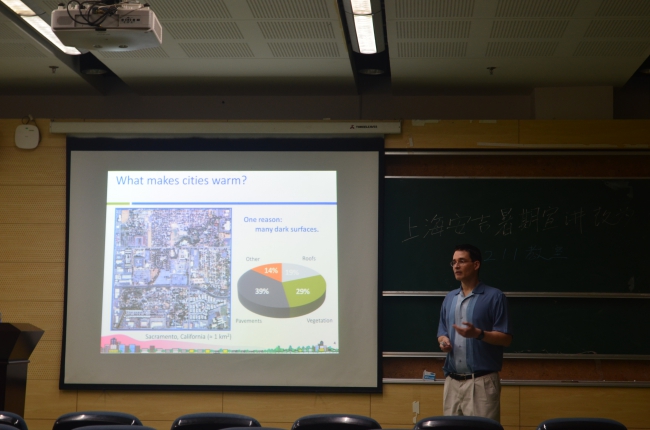The 242th Fellow Traveler Academic Forum was held successfully in room 103 of Tongda Pavilion at 10a.m. on May 26th,2016, which was hosted by Li Hui and given by Dr. Ronnen Levinson. The topic is Cool news from the USA and China: Using reflective roofs, walls, and pavements to cool our buildings and cities.
Dr. Ronnen Levinson is a Staff Scientist and Leader of the Heat Island Group at Lawrence Berkeley National Laboratory (LBNL) in Berkeley, California. Within his research portfolio he develops cool roof, wall, and pavement materials; improves methods for the measurement of solar reflectance; and quantifies the energy and environmental benefits of cool surfaces. Dr. Levinson collaborates with researchers and regulators from the U.S., China, India, Brazil, and Mexico to advance the appropriate use of cool materials in warm climates. He serves on the boards and technical committees of the Cool Roof Rating Council and the Global Cool Cities Alliance, and advises policymakers, code officials, utilities and building rating programs about cool surfaces. He holds a B.S. in engineering physics from Cornell University and an M.S. and a Ph.D. in mechanical engineering from the University of California at Berkeley. He has authored or co-authored over 60 publications, and serves on the editorial boards of Energy & Buildings and Advances in Building Energy Research.
The speed is indeed impressive. Increasing the albedo (solar reflectance) of roofs, walls, and pavements can cool our buildings and cities, saving energy and carbon. Recent innovations from the USA include (1) a Cool Roof Time Machine that determines the long-term performance of high-albedo “cool” roofs in less than three days; (2) an online map of roof albedos in five California cities; (3) a life cycle assessment (LCA) tool that compares the energy use and emissions of cool and traditional pavements; and (4) a project to develop and assess the benefits of high-albedo cool walls.
A five-year collaboration between China and the USA has shown that cool roofs save energy and carbon in all hot-summer Chinese climates. Credits for cool roofs and cool walls in hot-summer climates have been added to several Chinese building standards. Chinese researchers are working with the Chinese government and Lawrence Berkeley National Laboratory (LBNL) to test the long-term performance of cool roofing products in many cities across China. This may lead to a product rating system for cool roofs in China.
At the end of the forum, teachers and students present raised many meaningful questions which were solved by Dr. Ronnen Levinson carefully and patiently.
